Brain Superpower: Eli’s Story
March 8, 2023

 |
By: Scott Williams Counsellor, Clinical Supervisor & Head of Neurofeedback |
Brain Superpower: Eli’s Story
The first time I met Eli I knew I was going to like him. Eli was a polite and cooperative 11 year old boy, who was not averse to a little bribery when he started to get bored. He came to the appointment with his grandmother, a specialized nurse who was extremely knowledgeable about medical issues and knew a thing or two about life. Nonetheless, like most people who get a brain map, I could tell they weren’t sure quite what to expect.
Eli had been diagnosed with Autism Spectrum Disorder and ADHD, was struggling in school, had issues with self-regulation and outbursts, and was generally what we might describe as “dysregulated”. The word “oppositional” had been bantered around a few times during our first meeting as well. Eli’s early life had been filled with challenges, and some measure of heartbreak. He was an active kid, as a recently broken arm could attest. Eli was fearless and often impulsive: A combination that makes any caregiver cringe.
In the fall of 2021 Eli had his first brain map. His grandparents were concerned about potential depression, issues with symptoms of autism, problems sleeping, and ADHD.
Here is one of the graphs from his first report:
The red in this graph represents his grandparent’s estimates of problematic areas before the testing began. More pink means a bigger area of concern. The green pie wedges show the results of the EEG brain map: Here, a big green wedge means there were relatively more markers identified for that underlying condition. |
Here’s another way of comparing what Eli’s grandparents suspected, compared to what the test showed at Time 1:
In our next meeting with Eli’s grandparents, we discussed the ways in which the findings lined up with their personal experiences of Eli, or of his previously diagnosed conditions. That is, their fears about Anxiety, Autism, and Insomnia were all confirmed. However, they really wondered about his diagnosis of ADHD, which seemed to be missing from the test results. They were also very interested in learning more about the Depression, Dyslexia, and OCD which were not on their radar, yet the testing revealed there were some indicators of those types of brain performance challenges impacting Eli. Was the test wrong? Or were their underlying issues they never knew about?
I helped them to understand Eli’s confirmed diagnoses of ADHD and Autism were essential in helping us make sense of his Time1 results: Many areas of Eli’s brain were much more dysregulated, erratic and overactive. These were contributing to the wide range of unexpected markers for anxiety, depression, insomnia and dyslexia. Simply put, his dysregulated brain was impacting many areas of his day to day functioning… making it harder for him to sleep well, manage his emotions, and make good choices in the moment.
After I explained this to them, the family told me what I already knew: that Eli was a really great kid inside, but that he often seemed to be the victim of things he could not control. They really wanted to help Eli to improve these storms of chaos brewing within his brain. So, over the next 5 months Eli took part in 32 neurofeedback brain training sessions. Over that time, as you can see from this testimonial below, something had changed.
In his grandmother’s words:
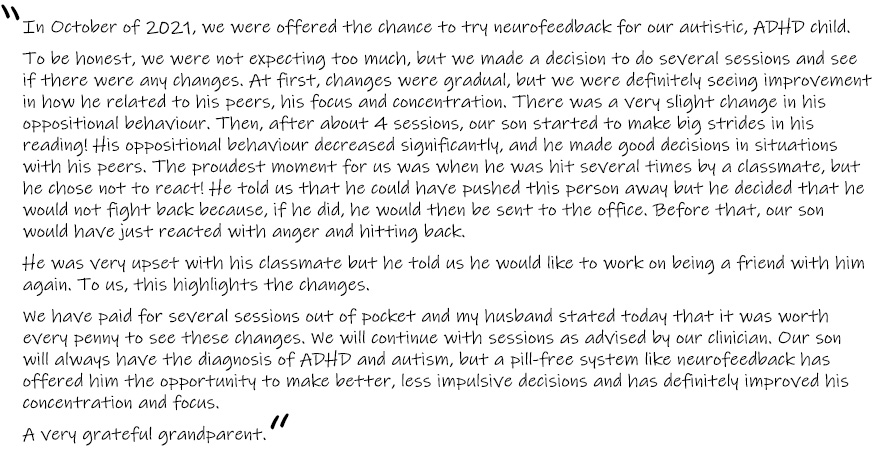
Others reported seeing meaningful changes too…
In the time since starting brain training, Eli began to read. Eli’s teacher reported that Eli was a “very different kid” after 5 months of brain training, and much more pleasant to be around. He wasn’t getting in fights at school.As the months progressed it was apparent that Eli presented as less fidgety, better able to engage with the neurofeedback and whatever he was watching. Clearly, something was happening in Eli’s brain: His brain performance was changing, and his grandparents really wanted to see what had happened with Eli’s brain in the past six months.
So we ran a second Brain Map. Here’s what that second scan revealed:
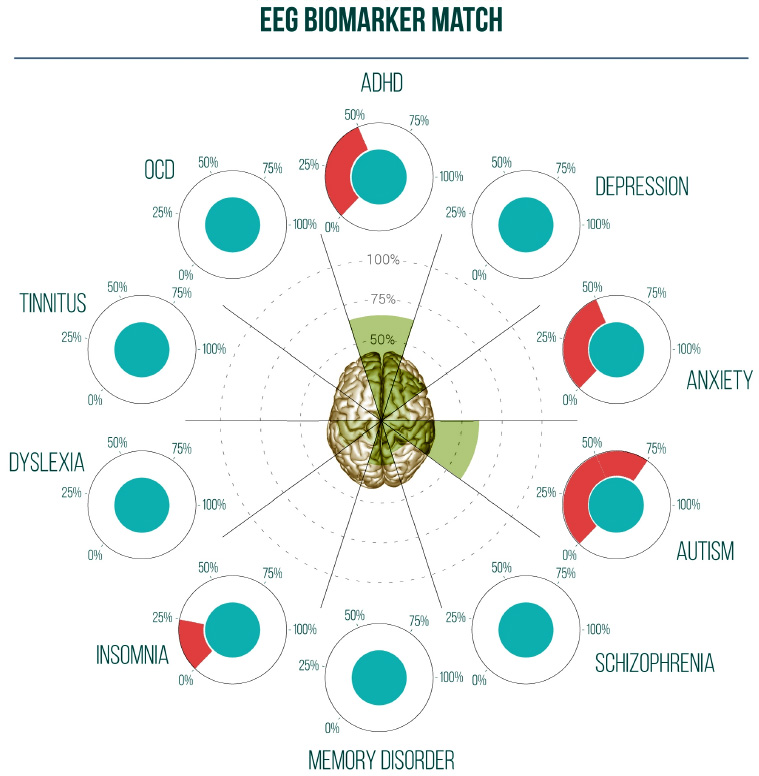
You don’t have to know anything about this test to see that these two results look very different. Look back at the green pie pieces in the first scan and then come back to this one. Notice anything? Eli’s diagnosis of ADHD and autism now appear, if anything, to be even MORE pronounced on Brain Map #2 compared to the first test. But where did all the other symptoms go? |
Here is a summary table comparing what Eli’s grandparents suspected, compared to what the test showed at Time 2:
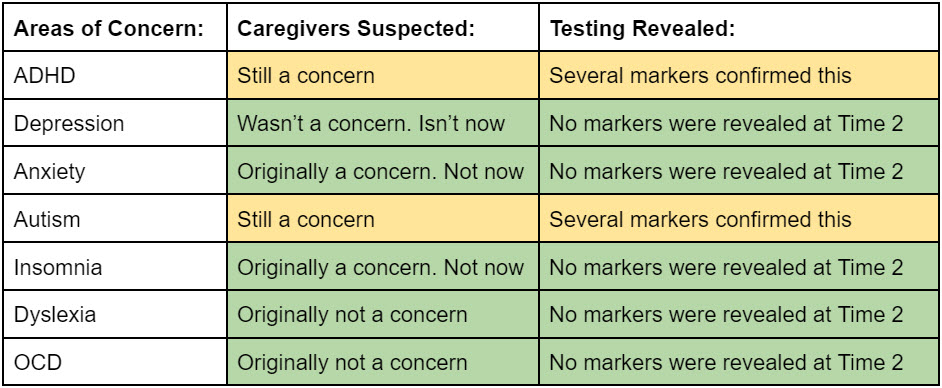
The family’s two main concerns now show several markers confirming both of Eli’s diagnosis. Because of this agreement between their concerns and the Brain Map, there are no longer any sections coloured red: Instead, those two areas are yellow, indicating that they still need work, which is exactly what the family expected to find.
Furthermore, all of the other yellow areas identified at time1 either weren’t a concern to begin with or no longer a concern now, and the brain map confirmed that no markers warned of those types of brain performance challenges any longer.
So… what happened to Eli?
Training Eli’s brain changed the way he was able to process his world and cope with his feelings. It impacted his sleep, his energy, his frustration levels and his resilience. Overall, his mental health improved dramatically as his brain performance improved. And once that dysregulation began to fade, and Eli’s brain became more regulated, his temporary issues with depression, anxiety and insomnia began to have less impact on his day to day behaviour and on his experience of himself and his abilities. Finally, Eli has a chance to gain control of who he wants to be!
The second scan shows a brain that is still operating with his diagnosis of ADHD and autism, but now it is free of much of the other “noise” that was contributing to everything from disruptive behaviour to Elis’ ability to cope with his world. Perhaps those two remaining markers will be reduced even more if Eli receives more brain training sessions. Or maybe his markers will reduce naturally as Eli matures, now that he feels more in control of himself. Only time will tell.
Brain mapping technology is designed to help people learn crucial information about their brain function and observe dysregulated areas of the brain. It identifies specific regions of interest (ROIs) and observes potential issues related to frequencies in a specific area of the brain (that’s a lot so think of it this way – a certain frequency in a specific place that does a particular thing). Clients who wish to go on to do brain training can access personalized protocols for their advanced brain training sessions once the brain is more regulated.
Reports are individualized and designed to provide both clinical assessment and clear, concise, usable recommendations that you can get started on immediately. Your clinician will include evidence-based strategies that are field-tested and at times, counter-intuitive, but highly relevant. People also appreciate the comprehensive reports that accompany brain mapping, as well as the practical advice and resources. We know that tests are almost meaningless if they don’t provide usable results that you can understand, so we endeavor to make individualized recommendations designed to help you, or someone you love, find the help you have been looking for.
Neurofeedback brain training uses repetition to teach the brain to operate in a healthy way. Clients watch videos or play low impact games and the neurofeedback machine uses audio, and sometimes video, to reward the brain when it is in the “green zone” and acting in an optimal fashion. Neurofeedback convinces the brain 256 times per second to become more regulated, and after a while that change is semi-permanent/permanent (neuroplasticity) depending on circumstances. Clients traditionally do 30-50 sessions over a number of weeks or months. The results speak for themselves.
Although we can’t guarantee results similar to Eli’s for all people, we have completed thousands of sessions of neurofeedback with clients and staff and it is impossible to ignore the findings of brain scans, reports of improved quality of life, testimonies of teachers and pediatricians and family members, and changed attitudes and coping capacity for dozens of clients.
If you are interested in further information about brain mapping or neurofeedback, or would like to read more documented testimonials from actual clients, check out our links on our website here. Clients with autism funding may be eligible to apply funding for brain mapping and/or neurofeedback brain training.
To talk to someone about whether or not brain mapping and/or neurofeedback is right for you or someone you know, email us at info@pivotpoint.ca.
To book a brain map right now, visit our booking page and select your city to find upcoming dates and available times.
We hope to create the turning point for many great Eli’s of the world, and to help their families find their way back on the road to greater success and happiness.


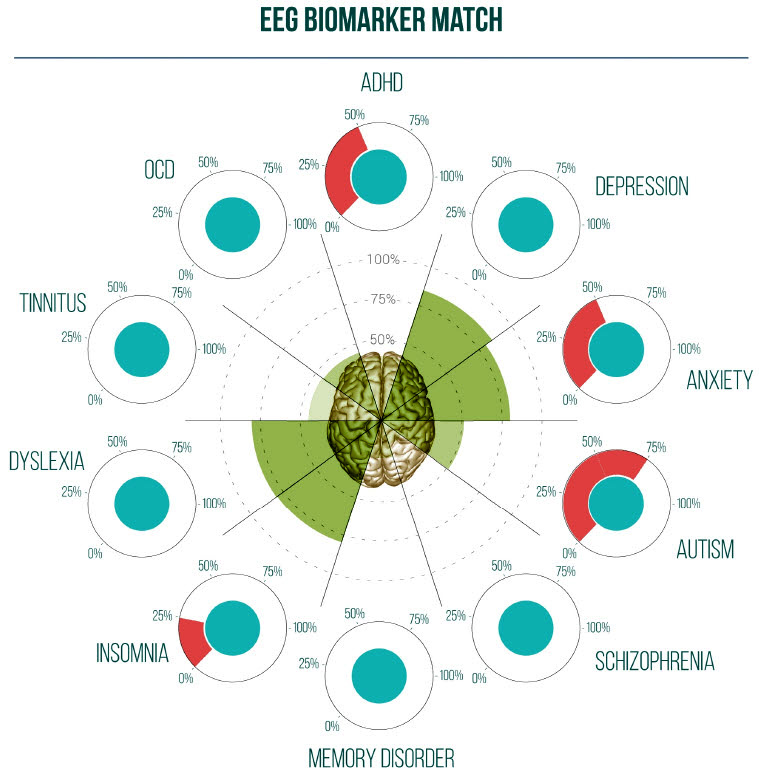
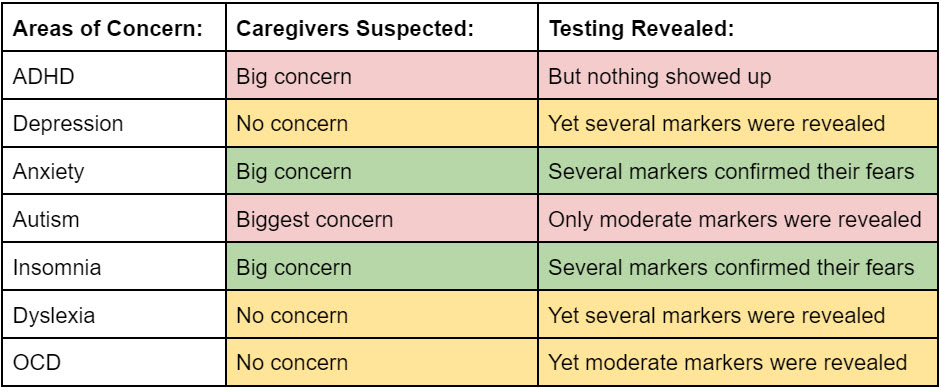
 Ontario Regional Manager
Ontario Regional Manager

 Complex Care Program Manager
Complex Care Program Manager Adult Services & Transition Planning Program Manager
Adult Services & Transition Planning Program Manager



